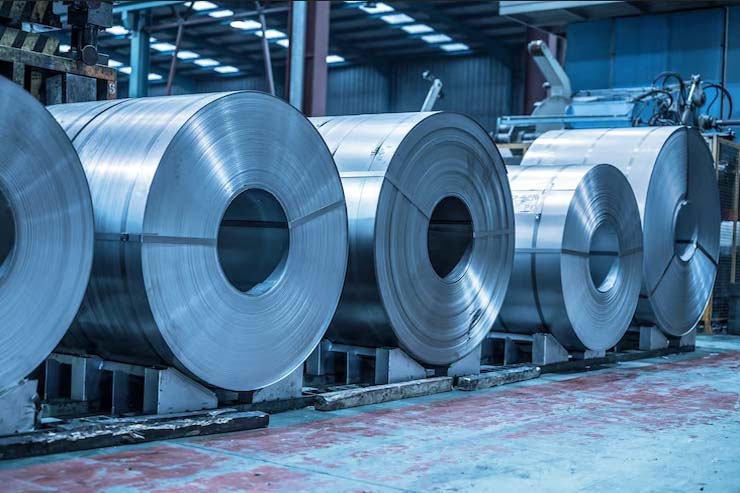COLD ROLLED CLOSED ANNEALED (CRCA)

Cold Rolled Steel Strip is produced, as the term suggests by the further rolling of HR (HOT ROLLED) STRIPS. Prior to cold rolling, the surface scale of HR has to be removed, normally by the Pickling Process which uses mechanical manipulation (around small diameter rolls) and acid to dissolve the surface scale. The surface is then washed to remove the acid and a light oil added to prevent rusting.
Why Cold Rolling:-
- Improve the surface finish
- Improve the thickness tolerances
- To offer a range of “tempers”
- As a preparation for surface coating
Cold rolling steel process
Cold-rolling steel is the process of steel flattening by passing the steel through a series of rollers. It is called Cold Rolling (or Cold Rolled) because the steel is kept below its recrystallization temperature. Cold rolling steel makes it up to 20% stronger and improves the surface finish. Cold-rolled sheets and strips come in various conditions: full-hard, half-hard, quarter-hard, and skin-rolled.
This cold rolling process and equipment change the mechanical properties of the steel, producing certain useful characteristic combinations*, including (but not limited to):
Ductility
Hardness
Stiffness
Strength
*Based on customer requirements.
We have two rolling stations. The initial cold rolling is undertaken on a more powerful “break down” mill that is capable of heavy reductions. After annealing to remove the stress and work hardening introduced in the process, the final cold rolling or “skin-pass” takes place. This is a light reduction (typically 3%) to improve the surface finish.
Our Cold rolling mills are reversing mills. A reversing mill is where the steel enters the rolling mill from one side, passes through the other side and then comes back through the mill again. Normally it will go left to right through the mill a number of times being rolled a little thinner each time it goes through.
Cold rolled strip can be produced in various conditions such as skin-rolled, quarter hard, half hard, full hard depending on how much cold work has been performed. This cold working (hardness) is often called temper, although this has nothing to do with heat treatment temper.
In skin rolling, the metal is reduced by 0.5 to 1% and results in a surface that is smooth and the yield point phenomenon–excessive stretching and wrinkling in subsequent operations, is eliminated. This makes the metal more ductile for further forming and stretching operations.
Quarter Hard, Half Hard, Full Hard stock have higher amounts of reduction, up to 50%. This increases the yield point; grain orientation and material properties assume different properties along the grain orientation. However, while the yield point increases, ductility decreases.
Quarter Hard material can be bent (perpendicular to the direction of rolling) on itself without fracturing. Half hard material can be bent 90º; full hard can be bent 45º. Thus, these materials can be used for in applications involving great amounts of bending and deformation, without fracturing.
Classical Cold Rolled is produced on narrow strip mills typically offering widths up to 500mm with “close” gauge control and a wide range of sizes, qualities and hardness’s.
Cold rolled sheet products are available for a multitude of applications such as appliances, automobiles, agricultural tools etc. They offer better control of thickness, shape, width, surface finish, and other special quality features that compliment the emerging need for highly engineered end use applications. To meet the various end use requirements, cold-rolled sheet products are metallurgically designed to provide specific attributes such as high formability, drawability, high strength, high dent resistance, enamelability, and paintability.
The first step in manufacturing Cold Rolled Sheet Products involves cold reducing coils of hot-rolled, pickled product to a thinner thickness. The primary feature of cold reduction is to reduce the thickness of hot-rolled coils into thinner thicknesses that are not generally attainable in the hot rolled state. The cold reduction operation induces very high strains (work hardening) into the sheet; thus, the sheet not only becomes thinner, but also becomes much harder, less ductile, and very difficult to form. However, after the cold-reduced product is annealed (heated to high temperatures), it becomes very soft and formable. In fact, the combination of cold reduction and annealing lead to a refinement of the steel that provides very desirable and unique forming properties for subsequent use by the customer.
The hot-rolled, pickled coils incoming to the cold reduction mill are of excellent quality attributes. The pickling operation is well-controlled to assure that all the oxides formed during hot rolling are removed. The thickness of the hot-rolled strip is important in that the properties of the final cold rolled and annealed product is influenced by the percent of cold reduction. This means that the thickness of each hot-rolled coil is carefully controlled to provide the mill with a specific thickness to achieve the proper percent cold reduction. Among other things, the percent of cold reduction affects the forming behavior of the product after annealing.
The production of a specific thickness of cold rolled sheet to meet an end user’s requirements involves sophisticated processing. Steel chemistry, hot strip mill processing variables, pickling practices, cold-rolling mill practices, annealing practices, and finally, temper rolling practices all have a role in achieving the manufacture of top quality cold-rolled sheet products. This product is manufactured for a large number of applications that require a variety of properties from fairly simple to very sophisticated. The product is typically available at thickness as low as 0.10 mm to 5.00 mm.

Cold rolled closed annealed (crca)
CRCA steel strip is manufactured by WALZEN in medium and high carbon grades of steel. CRCA is available in the below range :
| Specification | Grade | %C | %Mn | % P (max.) | % S(max) | % Si (max) | Size range |
|---|---|---|---|---|---|---|---|
| Medium & High Carbon | C40 | 0.35-0.42 | 0.60-0.90 | 0.035 | 0.025 | 0.35 | Width: 25mm to 300mm |
| C45 | 0.43-0.48 | 0.60-0.90 | 0.035 | 0.025 | 0.35 | ||
| C55 | 0.50-0.60 | 0.60-0.90 | 0.035 | 0.025 | 0.35 | ||
| C62 | 0.60-0.67 | 0.60-0.90 | 0.035 | 0.025 | 0.35 | Thickness: 0.40 to 2.00mm | |
| C80 | 0.75-0.85 | 0.60-0.90 | 0.035 | 0.025 | 0.35 | ||
| Surface | Bright | ||||||
| Edges | Available in SLIT / MILL Edges | ||||||
| Tolerance | On Width & Thickness as per BIS/International Standards. | ||||||
| Hardness | As per customer requirements | ||||||


